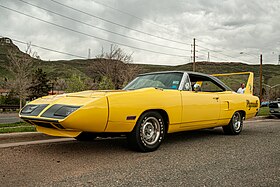| Plymouth Superbird | |
|---|---|
 | |
| Overview | |
| Manufacturer | Plymouth (Chrysler) |
| Production | 1970 |
| Assembly | Detroit, Michigan (Lynch Road Assembly) |
| Designer | Gary Romberg[1] |
| Body and chassis | |
| Class | muscle car, race car |
| Body style | 2-door coupe |
| Layout | FR layout |
| Platform | B-body |
| Related | Plymouth Road Runner Dodge Charger Daytona |
| Powertrain | |
| Engine | 426 cu in (7.0 L) Hemi V8 440 cu in (7.2 L) Super Commando V8 |
| Transmission | 4-speed manual 3-speed automatic Torqueflite 727 |
| Dimensions | |
| Wheelbase | 115.8 in (2,941 mm)[2] |
| Length | 221 in (5,613 mm)[2] |
| Width | 76.4 in (1,941 mm)[2] |
| Height | 61.4 in (1,560 mm)[2] |
| Curb weight | 3,841 lb (1,742 kg)[3] |

The Plymouth Superbird is a highly modified, short-lived version of the Plymouth Road Runner with applied graphic images as well as a distinctive horn sound, both referencing the popular Looney Tunes cartoon character Road Runner. It was the factory's follow-up stock car racing design, for the 1970 season, to the Dodge Charger Daytona of 1969, and incorporated many engineering changes and modifications (both minor and major) garnered from the Daytona's season in competition.[4]
The car's primary rivals were the Ford Torino Talladega and Mercury Cyclone, a direct response to the Mopar aero car. It has also been speculated that a motivating factor in the production of the car was to lure Richard Petty back to Plymouth.[5] Both of the Mopar aero cars famously featured a protruding, aerodynamic nosecone, a high-mounted rear wing and, unique to the Superbird, a horn mimicking the Road Runner's signature "beep, beep."[6]
Superbirds equipped with the top-of-the-line 426 cu in (7.0 L) Hemi engine with a pair of four barrel Carter AFB carburetors (2x4bbl) producing 425 hp (317 kW) could accelerate from 0 to 60 mph (97 km/h) in 5.5 seconds.[7]
- ^ Pearce, Al (2020-02-04). "Gary Romberg, The Rocket Scientist Behind NASCAR's 1970 Plymouth Superbird, Dies At 85". Autoweek. Retrieved 2023-07-28.
- ^ a b c d Cite error: The named reference
aerowarriorswas invoked but never defined (see the help page). - ^ The Auto Editors of Consumer Guide (2007-01-16). "HowStuffWorks "1970 Plymouth Road Runner Superbird: A Profile of a Muscle Car"". Musclecars.howstuffworks.com. Retrieved 2011-11-20.
- ^ Sessler, Peter C. (2001). Dodge & Plymouth muscle car red book (2nd ed.). Osceola, WI: MBI Pub. Co. p. 134. ISBN 978-0760308011. Retrieved 13 February 2015.
- ^ Chris Woodyard (November 3, 2013). "Is a wacky '70 Plymouth Superbird worth $500,000?". USA TODAY.
- ^ "Plymouth Road Runner Superbird, 1970 Road Runner Superbird | Conceptcarz.com - Pictures, Pricing, Information, Wallpaper, History". Conceptcarz.com. Retrieved 2011-11-20.
- ^ "Classic Car Database - 1970 Superbird Specs, Colors, Facts, History, and Performance". MyClassicGarage. SpeedDigital. Retrieved 26 June 2015.